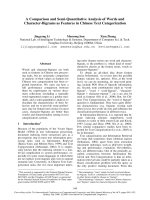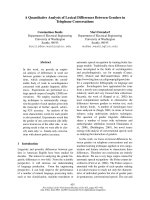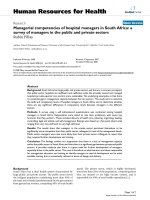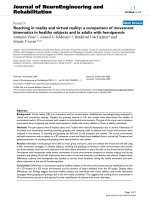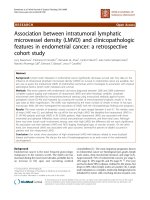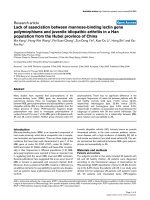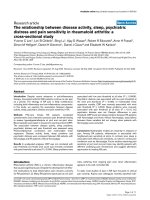Fever phobia: A comparison survey between caregivers in the inpatient ward and caregivers at the outpatient department in a children’s hospital in China
Bạn đang xem bản rút gọn của tài liệu. Xem và tải ngay bản đầy đủ của tài liệu tại đây (431.19 KB, 9 trang )
Dong et al. BMC Pediatrics (2015) 15:163
DOI 10.1186/s12887-015-0475-8
RESEARCH ARTICLE
Open Access
Fever phobia: a comparison survey
between caregivers in the inpatient ward
and caregivers at the outpatient
department in a children’s hospital in China
Lili Dong1,2, Jiahui Jin1, Yili Lu1, Lili Jiang1 and Xiaoou Shan1*
Abstract
Background: Fever in children is one of the most common clinical symptoms and a chief complaint and a main
reason that caregivers took the children to the outpatient service or admitted to hospital. Studies have found that
the majority of parents surveyed at a hospital pediatric clinic held unrealistic and unwarranted concerns about
fevers, first termed as ‘fever phobia’ by Schmitt in 1980. In the present study, we explore whether ‘fever phobia’
exists in Chinese caregivers and investigate whether such phobia is alleviated when admitted to hospital after
propaganda of fever related knowledge by doctors and nurses.
Methods: A questionnaire was distributed to caregivers of children who visited the pediatric outpatient department
and those with caregivers in the wards between June 2012 and Feb 2013 in Wenzhou, China.
Results: Data were obtained from 621 caregivers, 305(49 %) from the OPD and 316(51 %) from the ward. Most
caregivers of the two groups (OPD vs. ward group, 75.1 vs. 74.4 %) believed fever could cause brain damage.
77.7 % (76.0 vs. 81.3 %) caregivers were very worried when their children had fever and 12.8 % (14.1 vs. 11.4 %)
caregivers would check the temperature within 30 min. Moreover, 68.0 % (63.0 vs. 72.8 %, P < 0.05) caregivers
would give their children antipyretics during sleep and 39.9 % (40.3 vs. 39.6 %) would administrate antipyretics
when temperature was above 38 °C. After admitted to hospital, 83.9 % caregivers stated to have received education
about fever and 96.5 % felt relieved. Less caregivers (ward group vs. OPD, 42.4 vs. 46.9 %, P < 0.05) from ward group
would give antipyretics with a temperature under 38.5 °C and less (0.6 vs. 4.9 %, P < 0.05) preferred cold sponging as
physical cooling method compared to the OPD caregivers. Alarmingly, more caregivers (42.7 vs. 34.3 %, P < 0.05) in the
ward group believed fever could lead to death or/and deafness (17.4 vs. 10.5 %, P < 0.05) and even 0.6 % caregivers in
the ward group chose aspirin when the children had fever.
Conclusion: ‘Fever phobia’ also exists in Chinese caregivers. Fever related knowledge propaganda after admitted to
hospital did not work effectively to improve the caregivers’ understanding and management of fever and an effective
way to alleviate ‘Fever phobia’.
Keywords: Fever, Fever phobia, Caregivers, Ward, Outpatient, Knowledge
* Correspondence:
First author: Lili DongSubmitting author: Lili Dong
1
Department of Pediatric, Second Affiliated Hospital of Wenzhou Medical
University, 109 Xueyuan Road, Wenzhou, Zhejiang Province 325027, China
Full list of author information is available at the end of the article
© 2015 Dong et al. Open Access This article is distributed under the terms of the Creative Commons Attribution 4.0
International License ( which permits unrestricted use, distribution, and
reproduction in any medium, provided you give appropriate credit to the original author(s) and the source, provide a link to
the Creative Commons license, and indicate if changes were made. The Creative Commons Public Domain Dedication waiver
( applies to the data made available in this article, unless otherwise stated.
Dong et al. BMC Pediatrics (2015) 15:163
Background
Fever is very common in children, usually indicating an
underlying viral infection which is often harmless and
self-limiting, while fever is sometimes a response to severe bacterial infection requiring timely and appropriate
medical intervention [1], and always leading to a frequent concern for parents and caregivers [2, 3]. Parents
and caregivers often misinterpret fever as being dreadful
and harmful to their children, and believed that fever
could cause brain damage or even death [4–6]. Fear of
fever may sometimes results in frequent visits to the
emergency department or clinic unnecessarily, thus
leading to unscheduled physician visits, inappropriate
treatments and unexpected financial budget [7]. Such
misconception about fever has been coined as “fever
phobia” by Schmitt in 1980 [4]. Since Schmitt’s study
of “fever phobia” in caregivers, similar studies have
been conducted in many other countries to describe
the unrealistic fears about fever in both caregivers
and healthcare professionals [8, 9]. Though more than
20 years has passed after the initial study, fever phobia still exists in the United States as well as in the
other countries [10–16].
The wide existence of ‘Fever phobia’ reveals that the
majority of caregivers think fever is harmful to their children and regard it as a disease rather than a symptom or
sign of illness [4, 17–19], which explains the fear of fever
and further intensifies the popularity of ‘Fever phobia’.
In China, we found that some caregivers even administer
antipyretics without doctors’ advice and ask pediatricians
for antibiotic infusion for the purpose of rapid reduction
of temperature, reflecting that ‘Fever phobia’ also exists
in China and it may be more severe among caregivers.
Besides, physical cooling methods are also included,
such as undressed, tepid sponging, cold sponging, cold
toweling, alcohol sponging or wine sponging. Actually,
fever is a natural adaptive process which may improve
the body’s resistance to future infections and the frequent use of antipyretics to artificially reduce the body
temperature may inhibit this process [20]. Moreover, in
children with febrile illness, no evidence has been found
that the height of temperature correlates with the severity of illness except for that in very young children
[21] and no evidence suggests that fever reducing improves morbidity or mortality [22]. Studies have shown
that physical methods of temperature reduction do not
treat the cause of fever and may cause discomfort, shivering, resulting in vasoconstriction and an increase in
temperature and metabolism [23–25], caregivers still
ignorantly apply them.
According to previous studies, education in the waiting place could help caregivers know well about fever
and deal with it appropriately [26–29]. To the best of
our knowledge, although many reports related to ‘Fever
Page 2 of 9
phobia’ have been conducted, no studies about the
difference between the outpatient department (OPD)
group and the ward group have been conducted.
Among most hospitals in China, education by doctors
or nurses about related diseases takes place after admission in the hospital.
Our objectives for this study is to explore caregivers’
attitudes towards fever and compare the attitudes between the OPD group and the ward group, and to determine whether the caregivers feel relieved and whether
the education works after admitted to hospital.
Methods
Design
A cross-sectional survey was conducted as face-to-face
interview between June 2012 and Feb 2013 in Wenzhou,
China, which is a city that lies in the middle of east
coast of China, southeast of Zhejiang province, and it is
the economic, cultural and transportation center of
Zhejiang. We selected a convenience sample of patients
who were available and consented to be in the study
while waiting at the OPD, and those with caregivers in
the wards. All the respondents in the ward group had
been educated for fever-related knowledge when interviewed. Children less than 3 months old and caregivers
with experience of working in healthcare institutions
and those who had the experience of hospitalization
were excluded. According to Chinese Tradition, the questionnaire was re-administrated after Schmitt’, and was validated using content validity by an expert panel that
comprised a senior clinical pediatrician, a senior clinical
nurse and clinical educators. It consists of demographic
information (e.g. patients’ age, place of residence) and
18 questions including caregivers’ knowledge about
fever, causes of fever, possible effects of fever, concerns
about fever, fever management, and source of information about fever. Additional information was collected
from caregivers in the ward as to whether caregivers
felt relieved, and received education from doctors and
nurses after admitted to hospital. Caregivers gave verbal
and written consent. The Second Hospital of Wenzhou
Medical University Research Ethics Committee approved
the study.
Statistical analysis
Data analysis was performed with SPSS 19.0 for Windows. Student’s t test was used for continuous variables; χ2 analysis was used for dichotomous variables.
If the p value was <0.05, it was considered significant.
Results
Demographics
Of all the 621 caregivers, 316 (51 %) from the ward and
305 (49 %) from the OPD agreed to be in the survey and
Dong et al. BMC Pediatrics (2015) 15:163
Page 3 of 9
were interviewed. The ward group and the OPD group
differed demographically by both ‘caregiver’s occupation’
and ‘place of residence’ (Table 1). Regarding to caregiver’s occupation, in the ward group, 33.9 % were house
wives or had no job, 32.0 % self-employed, 14.2 %
workmen, 10.4 % institutional organization workers and
8.2 % worked for enterprise, while in the OPD, the most
were workmen, accounting for 34.2 %, followed by
27.8 % caregivers who had no job, 19.9 % self-employed,
10.3 % working for enterprise and 6.4 % institutional
Table 1 Distribution of demographic characteristics
Variables
Total
OPD
Ward
n = 621 (%)
n = 305 (%)
n = 316 (%)
Mothers
472 (76.0)
221 (72.5)
251 (79.4)
Fathers
126 (20.3)
73 (23.9)
53 (16.8)
21 (3.4)
11 (3.6)
12 (3.8)
88 (14.2)
49 (16.1)
39 (12.3)
26–35
414 (66.7)
193 (63.3)
221 (69.9)
36–45
103 (16.6)
57 (18.7)
46 (14.6)
16 (2.6)
6 (2.0)
10 (3.2)
p value
Caregivers
Grandparents
0.085
Caregiver’s age, years
25 or younger
46 or older
0.171
Caregiver’s occupation
Unemployed (House wife)
191 (30.8)
84 (27.8)
107 (33.9)
Workman
149 (24.0)
104 (34.2)
45 (14.2)
Self-employed
162 (26.1)
61 (19.9)
101 (32.0)
Enterprise
58 (9.3)
32 (10.3)
26 (8.2)
Institutional organization workers
53 (20.3)
20 (6.4)
33 (10.4)
8 (1.3)
4 (1.4)
4 (1.3)
9 (1.4)
3 (1.1)
6 (1.9)
Government officer
<0.001
Educational level
Illiterate
Primary school
66 (10.6)
28 (9.8)
38 (12.0)
Middle school
228 (36.7)
120 (42.1)
108 (34.2)
High school
139 (22.4)
56 (19.6)
83 (26.3)
College
159 (25.6)
78 (27.4)
81 (25.6)
Wenzhou, Zhejiang
501 (80.7)
249 (81.6)
252 (79.7)
Non Wenzhou
120 (19.3)
56 (18.4)
64 (20.3)
Countryside
367 (59.1)
180 (59.2)
187 (59.2)
County town
101 (16.3)
40 (13.0)
61 (19.3)
City
153 (24.6)
85 (27.8)
68 (21.5)
1
342 (55.1)
178 (58.4)
164 (51.9)
2
241 (38.8)
112 (36.7)
129 (40.8)
38 (6.1)
15 (4.9)
23 (7.3)
0.143
Native place
0.550
Place of residence
0.045
Number of children
3 or more
0.196
Annual income of the family
$5000 or less
144 (23.2)
65 (21.4)
79 (24.9)
$5000–8000
204 (32.9)
107 (35.0)
97 (30.7)
$8000–16,000
167 (26.9)
80 (26.3)
87 (27.6)
$16,000 or more
106 (17.1)
53 (17.3)
53 (16.9)
0.583
Dong et al. BMC Pediatrics (2015) 15:163
Page 4 of 9
organization workers, separately (p < 0.05). Caregivers
living in countryside accounted for 59.2 % in both of the
two groups, while 21.5 % from the ward group lived in
the city and those who lived in the city from the OPD
group accounted for 27.8 % (p < 0.05). The remaining
demographic variables were comparable between groups.
Mothers accounted for 76.0 % of those interviewed, and
66.7 % of those interviewed were between the ages 26
and 35. Among those interviewed, 36.7 % graduated
from middle school, 25.6 % from college, 22.4 % from
high school, 10.6 % from primary school and 1.4 %
received no education. Most of those interviewed
(80.7 %) were local residents, and 55.1 % of the caregivers interviewed had only one child, 38.8 % had 2,
while 6.1 % had three or more. At the time of interview, the family annual income was $5000 or less
(23.2 %), $5000–8000 (32.9 %), $8000–16,000 (26.9 %)
or $16,000 or more (17.1 %). (All the data above were
shown in Table 1).
Definition of fever and high fever
When asked about the definition of fever, 9.8 % caregivers (10.2 vs. 9.5 %) considered 37 °C as the threshold of fever, 39.8 % considered 37.5 °C, and a large
number of caregivers considered 38 °C. Except one in
the ward group who did not know, the rest defined
the temperature below 38 °C as fever. Moreover, the
most common high fever threshold was 39 °C, respectively reported by 55.4 % and 57.3 % caregivers,
then, followed by 38.5 °C (26.6 vs. 27.8 %) and 40 °C
(6.2 vs. 8.9 %). While the two groups did not differ
statistically on the definition of fever and high fever,
and data was specifically illustrated in Table 2.
Table 2 Definition of fever and high fever by caregivers
Variables
Total
OPD
Ward
n = 621 (%)
n = 305 (%)
n = 316 (%)
p value
Body temperature considered as fever (°C)
≥ 37
61 (9.8)
31 (10.2)
30 (9.5)
≥ 37.5
247 (39.8)
118 (38.7)
129 (40.8)
≥ 38
312 (50.2)
156 (51.1)
156 (49.4)
1 (0.2)
0 (0.0)
1 (0.3)
Unknown
0.726
Body temperature considered as high fever (°C)
≥ 37
1 (0.2)
1 (0.3)
0 (0.0)
≥ 38
53 (8.5)
35 (11.5)
18 (5.7)
≥ 38.5
169 (27.2)
81 (26.6)
88 (27.8)
≥ 39
350 (56.4)
169 (55.4)
181 (57.3)
≥ 40
47 (7.6)
19 (6.2)
28 (8.9)
1 (0.2)
0 (0.0)
1 (0.3)
Unknown
0.085
Knowledge about fever
With respect to the knowledge about fever, about
2.8%caregivers in the ward group would give antipyretics at the temperature of 37 °C, 39.6 % at the
temperature of 38 °C, 47.2 % at the temperature of
38.5 °C, 10.4 % at the temperature of 39 °C; While in
the OPD, the percentage of caregivers administrating
antipyretics at each temperature above were 6.6, 40.3,
44.9, 7.2 %, respectively. Moreover, three caregivers in
this group had even no idea. It was of statistical significance between the two groups.
The most common antipyretics chosen by caregivers
were ibuprofen, and the proportion in the ward group
and the outpatient group were 78.2 and 80.7 % separately. The percentage of caregivers (9.5 %) who would
use acetaminophen were the same between the two
groups. And the method of combining or alternating
ibuprofen and acetaminophen was also seen in 4.7 %
caregivers in the ward group and 3.9 % in the OPD
group. While 2(0.6 %) caregivers in the ward group
chose aspirin. The left 7.0 % in the ward group and
5.9 % in the outpatient group had other choices, mostly
were Chinese traditional medicine, such as Radix isatidis (banlangen), Qingkailing granules (qingkailingkeli),
Taurine Granules and Radix Bupleuri Oral Liquids
(Chaihukoufuye), and others included Compound Zinc
Gluconate and Ibuprofen Granules and suppositories.
And most of the caregivers, 63.0 % in the outpatient
group would awaken their febrile sleeping children for
antipyretics administration, while those in the ward
group were significantly more (p < 0.05) and the percentage was up to 72.8 %.
With regard to the way of getting antipyretics, 38.3 %
caregivers in the ward group and 29.2 % in the outpatient
group went to drugstores, but hospital was still the major
choice, 56.3 % in the ward group and 66.6 % in the outpatient group, while 5.4 % in the ward group and 4.3 % in
the outpatient group would go to both drugstore and hospital, as shown in Table 3 and there was statistical significance between the two groups (p < 0.05).
Even if there was not significant evidence showing any
benefits of physical cooling, 47.8 % in the ward group
and 44.6 % in the outpatient group, nearly half of the
caregivers still used tepid sponging for their feverish
children and there were significantly more caregivers
choosing cold sponging (0.6 vs. 4.9 %, p < 0.05). While 2
caregivers even chose wine sponging. There were 34.2 %
caregivers in the ward group and 24.6 % in the outpatient group choosing cold toweling, which was of statically significance (p < 0.05). In terms of those choosing
alcohol sponging, the number was nearly the same, besides, there was the convenient method fever cooling
patch preferred by 12.0 % in the ward group and 8.9 %
in the outpatient group. Then there were 6.6 %
Dong et al. BMC Pediatrics (2015) 15:163
Page 5 of 9
Table 3 Knowledge about fever
Variables
Total
OPD
Ward
n = 621 (%)
n = 305 (%)
n = 316 (%)
p value
Body temperature considered to give antipyretics (°C)
≥ 37
29 (4.7)
20 (6.6)
9 (2.8)
≥ 38
248 (39.9)
123 (40.3)
125 (39.6)
≥ 38.5
286 (46.1)
137 (44.9)
149 (47.2)
55 (8.9)
22 (7.2)
33 (10.4)
3 (0.5)
3 (1.0)
0 (0.0)
≥ 39
Unknown
0.046
Antipyretics used
Ibuprofen
493 (79.4)
246 (80.7)
247 (78.2)
Acetaminophen
59 (9.5)
29 (9.5)
30 (9.5)
Ibuprofen &Acetaminophen
27 (4.3)
12 (3.9)
15 (4.7)
2 (0.3)
0 (0.0)
2 (0.6)
Aspirin
Banlangen
a
1 (0.2)
0 (0.0)
1 (0.3)
Qingkailingkelib
3 (0.5)
1 (0.2)
2 (0.6)
c
Chaihukoufuye
2 (0.3)
1 (0.2)
1 (0.3)
Compound Xinbu Granulesd
3 (0.5)
1 (0.2)
2 (0.6)
e
Niuhuangsuankeli
3 (0.5)
1 (0.2)
2 (0.6)
Xiaoerqingrejiekelif
3 (0.5)
1 (0.2)
2 (0.6)
25 (4.0)
13 (4.3)
12 (3.8)
Yes
422 (68.0)
192 (63.0)
230 (72.8)
No
199 (32.0)
113 (37.0)
86 (27.2)
Drugstore
210 (33.8)
89 (29.2)
121 (38.3)
Hospital
381 (61.4)
203 (66.6)
178 (56.3)
30 (4.8)
13 (4.3)
17 (5.4)
0.032
Tepid sponging
287 (46.2)
136 (44.6)
151 (47.8)
0.469
Cold sponging
17 (2.7)
15 (4.9)
2 (0.6)
0.001
Cold toweling
93 (15.0)
75 (24.6)
108 (34.2)
0.01
Unknown
0.634
Giving antipyretics during sleep
0.009
Where to get antipyretics
Drugstore & Hospital
The method of physical cooling
Alcohol sponging
121 (19.5)
58 (19.0)
63 (19.9)
0.803
Fever cooling patch
65 (10.5)
27 (8.9)
38 (12.0)
0.197
Unknown/No
47 (7.6)
26 (8.5)
21 (6.6)
0.376
2 (0.3)
0 (0.0)
2 (0.6)
0.499
Wine
a
f
Radix isatidis; bQingkailing granules; cTaurine Granules and Radix Bupleuri Oral Liquids; dCompound Zinc Gluconate and Ibuprofen Granules; eTaurine Granules;
Qingrejie granules
caregivers in the ward group and 8.5 % in the outpatient
group who had never used the methods of physical cooling or had no idea (shown in Table 3).
Potential effects of fever
The most potential effects of fever predicted by caregivers was brain damage, which was up to 74.7 %, although there was no statistical significance between the
two groups (75.1 vs. 74.4 %, p > 0.05). There were significantly more caregivers in the ward predicting that death
was the second most possible complication of fever
(34.4 vs. 42.7 %, p < 0.05). According to the data obtained, 21.9 % caregivers believed fever can cause convulsion though without difference between the two
groups (22.6 vs. 21.2 %, p > 0.05). As for the loss of hearing, the percentage was obviously higher in the ward
group and it was statistically significant (10.5 vs. 17.4 %,
p < 0.05). In addition, 11.9 % caregivers (10.2 vs. 13.6 %)
regarded blindness as another possible danger of fever,
while a small number of caregivers (1.7 vs. 1.9 %) stated
Dong et al. BMC Pediatrics (2015) 15:163
Page 6 of 9
they “Have no idea” at all. Data were displayed in detail
in Table 4.
Table 5 How often temperature checked and level of
caregiver’s worrisome
Variables
How often temperature checked and level of caregiver’s
worrisome
A vast majority of caregivers took their febrile child’s
temperature at least every 2 h or more frequently,
32.7 % checked temperature every 1 to 2 h, 33.3 %
checked every 30 min to 1 h, 11.8 % did it every 15
to 30 min. While 1.0 % checked the temperature
every less than 15 min, only 20.6 % checked more
than 2 h. All the data obtained about frequency of
checking temperature between two groups was of no
statistical significance (p > 0.05). Among 621 caregivers surveyed, 7 caregivers stated they were not
worried at all, while 44.4 % were very worried and
34.3 % were extremely worried. Again, they did not
differ statistically (p > 0.05), as shown in Table 5.
Total
OPD
Ward
n = 621 (%)
n = 305 (%)
n = 316 (%)
p value
How often temperature checked
≤ 15 min
6 (1.0)
5 (1.6)
1 (0.3)
15–30 min
73 (11.8)
38 (12.5)
35 (11.1)
30 min–1 h
207 (33.3)
98 (32.1)
109 (34.5)
1 h–2 h
203 (32.7)
99 (32.5)
104 (32.9)
≥2 h
128 (20.6)
63 (20.7)
65 (20.6)
4 (0.6)
2 (0.7)
2 (0.6)
2 (0.7)
5 (1.6)
Unknown
0.648
Level of caregiver’s worrisome
Not worried at all
7 (1.1)
A little worried
125 (20.1)
71 (23.3)
54 (17.1)
Very worried
276 (44.4)
137 (44.9)
139 (44.0)
Extremely worried
213 (34.3)
95 (31.1)
118 (37.3)
0.116
Sources for information about fever
Doctors and nurses were considered to be the primary
source for information about fever, and the percentage
was significantly higher in the ward group than that in
the OPD group (53.3 vs. 43.0 %, p < 0.05). Compared
with the OPD group, more caregivers chose Internet as
their source for information about fever in the ward
group. As to the experience, the proportion is statically
higher in the ward group than that in the OPD group.
While there was no difference between the two groups
about the other sources for information of fever, such
as TV or newspapers, professional lectures and neighbors or relatives, seen in Table 6.
Discussion
Fever is defined as ‘an elevation of body temperature
above the normal daily variation, usually take the body
temperature 38 °C or higher as a criteria. It’s the most
common reason that caregivers took their children to
doctors, accounting for almost one third of all the
causes for children seeking medical advice [30–32].
However, the majority caregivers thought fever harmful
to their children and considered it as a disease rather
than a symptom or a sign of illness and necessary to be
treated, thus leading to parents waking up their children
to give antipyretics, in the pursuit of reducing to normal
temperature and unimaginable and unrealistic worrisome
about fever, namely ‘Fever phobia’ [4, 9, 33–36].
In our study, 9.8 % caregivers considered 37 °C as the
threshold of fever, 39.8 % considered 37.5 °C, and the
rest 50.2 % of caregivers considered 38 °C in the OPD.
Except one in the ward group who did not know, the
rest defined the temperature below 38 °C as fever. And
the most common high fever threshold was 39 °C, reported by 55.4 and 57.3 % caregivers, respectively, then
followed by 38.5 °C. But the less common high fever
threshold was 40 °C. Other studies have reported similar
findings. In Chang’s study, 81 % of participants considered temperature below 38 °C as the threshold of fever
and 69.6 % considered a temperature below 39 °C as the
threshold of high fever [37]. In Karwowska’s study, parents considered a temperature 37.9 °C as the threshold
of fever and 39.1 °C as high fever [13]. In Poirier’s study,
55 % parents considered a temperature below 37.8 °C as
Table 6 Sources for information about fever
Variables
Table 4 Potential effects of fever
Variables
Total
OPD
Ward
p value
n = 621 (%) n = 305 (%) n = 316 (%)
p value
Total
OPD
Ward
n = 621 (%)
n = 305 (%)
n = 316 (%)
Brain damage
464 (74.7)
229 (75.1)
235 (74.4)
0.838
Parent’s books
179 (28.8)
87 (28.5)
92 (29.1)
0.871
Death
240 (38.6)
105 (34.4)
135 (42.7)
0.034
Internet
139 (22.4)
58 (19.0)
81 (25.6)
0.048
Convulsion
136 (21.9)
69 (22.6)
67 (21.2)
0.669
Professional lectures
87 (14.0)
32 (10.5)
55 (17.4)
0.020
Neighbors or relatives
Blindness
74 (11.9)
31 (10.2)
43 (13.6)
0.185
Have no idea
11 (1.8)
5 (1.7)
6 (1.9)
0.806
Deafness
TV or newspaper
153 (24.6)
84 (27.5)
69 (21.8)
0.099
28 (4.5)
13 (4.1)
15 (4.7)
0.771
126 (20.3)
68 (22.3)
58 (18.4)
0.222
Doctors and nurses
300 (48.3)
131 (43.0)
169 (53.5)
0.009
Experience
155 (25.0)
45 (14.8)
110 (34.8)
<0.001
Dong et al. BMC Pediatrics (2015) 15:163
the threshold of fever and 17.5 % as a temperature below
38.9 °C as high fever [38]. After admitted to hospital,
though 83.9 % caregivers stated to have received education about fever and 96.5 % said to feel relieved, between
the two groups, there was no significant difference as to
the definition of fever and high fever at all, moreover, no
difference was found about the antipyretics used between the two groups as well. It seemed that caregivers
in China mainland had the same level of misunderstanding about the definition of fever as caregivers from other
countries and the education after admission to hospital
did not work effectively indicating that the education
might did not refer to the related knowledge, or the education was not accepted, or even the related knowledge
was rightly educated.
Among previously reported studies, 56 % parents were
very worried about the possible harm caused by childhood fever in United States [34], 50–60 % in a Singaporean research [39], 65 % in a UK one [15], and 86.8 %
parents in Taiwan stated to be worried [37]. In the
present study, we found that 44.4 % caregivers were very
worried and 34.3 % were even more worried. And
57.2 % would take their febrile children to hospitals at
night, 74.7 % thought fever could cause brain damage,
4.7 % would give antipyretics when the temperature was
higher than 37 °C and 38.0 % would choose 38 °C as
threshold for antipyretics, 68.0 % would wake up their
sleeping children for antipyretics, indicating a deep misunderstanding and unrealistic worrisome of fever, which
was consistent with previous studies [9, 34, 40]. Such
misunderstanding and worrisome of fever resulted in inappropriate or unnecessary treatments, thus leading to
unexpected harm to children. Besides, there were no significant differences between the two groups in the above
items, except that more caregivers in the ward group
would wake up their sleeping children for antipyretics
and thought deafness was one of the most potential effects of fever, suggesting the reason why the caregivers
receiving inpatient care could be more concerned is the
possibility of their child’s more severe disease. Moreover,
those caregivers in the ward group might think that the
fever would persist or get worse and could lead to more
serious damage to children, which also reflected that the
education after admission to the hospital did not work.
In previous studies, many kinds of harmfulness thought
by caregivers were related to fever, the most common
were convulsion, brain damage [4, 34, 39] and even death
[4–6]. Crocetti et al. found that 53 % caregivers thought
fever would rise if left untreated and 58 % thought fever itself could lead to brain damage or even death [34]. While
in our study, in the outpatient group, 75.1 % thought fever
could lead to brain damage, 34.4 % thought it could lead
to death, 22.6 % thought it could lead to convulsion,
10.5 % thought it could lead to deafness and 10.2 %
Page 7 of 9
thought it was blindness, while in the ward group, the percentage was 74.4, 42.7, 21.2, 17.4, 13.6 % respectively, consistent with the previous study, Enarson et al. found 74 %
parents thought fever dangerous and 90.3 % tried to reduce temperature [35]. The first three potential effects of
fever predicated by caregivers were brain damage, death
and convulsion, which may be the major reason why caregivers felt so worried about the fever and were in the pursuit of reducing to normal temperature. In fact, fever in
children were mostly caused by virus [21, 41, 42], and if
the children were with normal spirits and had sufficient
water without dehydration, it would disappear without
treatment.
Moreover, there are a number of physical cooling
methods used to reduce body temperature, including
undressing, sponging or toweling with tepid or cold
water or alcohol, and these are involved in convection
and evaporation but do not treat the underlying causes
of the fever and the physical methods can cause discomfort [43, 44], such as shivering, hypoglycemia, coma and
even death [4]. In our survey, though more caregivers in
the ward group chose cold toweling and less chose cold
sponging, there were equivalent caregivers in two groups
choosing tepid sponging, alcohol sponging, fever cooling
patch, and far more less caregiving did not know what
physical cooling methods or did not put that into use,
indicating that the education by doctors and nurses after
admitted to hospital did not work as no physical interventions for reducing temperature were recommended
in the recent published guideline for feverish illness for
children [20].
Our findings underline the existing of ‘Fever phobia’
in Wenzhou, China but not the value of education after
admission to a hospital in order to modify the caregivers’ understanding and management of fever. Caregivers took doctors and nurses as the first choice of
source of information about fever, while there was no
statistical significance between the two groups in most
items, indicating that the education might not work effectively. Though previous education [45–47] showed
positive effects, here it did not show fever-related education an effective action to improve the caregivers’ understanding and management of fever and an effective
way to alleviate ‘Fever phobia’. Thus there are yet a lot
that we can do to it.
Limitations
The findings of this study should be considered within the
following limitations. The study was undertaken at one
pediatric hospital and the sample was small thereby limiting the generalisability of other findings and probably not
being able to totally represent the national data. The caregivers interviewed had no experience of hospitalization,
limiting the findings of the understanding of fever in those
Dong et al. BMC Pediatrics (2015) 15:163
with the experience of hospitalization. We also care about
the external validity of our findings relating to the perceptions of doctors and nurses. Although the doctors and
nurses involved in the ward group survey have a variety of
training backgrounds, knowledge base and perspective
may differ when educating caregivers. Besides, there is
also the possibility that caregivers in ward group might be
more concerned due to their child’s more severe disease.
Here, the reasons for outpatient visits and hospitalization
were not studied and analyzed, which we will do during
the next related study.
Conclusions
“Fever phobia” is still widespread among caregivers and
the vast majority believes that fever is harmful and it
also exists in Chinese caregivers. In our study, it did not
show fever education an effective action to improve the
caregivers’ understanding and management of fever and
an effective way to alleviate ‘Fever phobia’. Considering
that there was no statistical significance between the two
groups in some items, and both caregivers in the ward
group and in the OPD group, doctors and nurses were
considered as the primary source of information, underlying possible problems with the education, which suggested the importance to guarantee that doctors and
nurses give parents correct and consistent information
in order to eliminate “fever phobia”, some related training might be necessary.
Page 8 of 9
3.
4.
5.
6.
7.
8.
9.
10.
11.
12.
13.
14.
15.
16.
17.
18.
Competing interests
The authors declare that they have no competing interests.
19.
20.
Authors’ contributions
XS was principal investigator of the study. She participated in the design of
the study, development of the questionnaire and drafting of the manuscript.
LD participated in the development of the questionnaire, data collection and
data analysis and took the lead on drafting the manuscript. JJ participated in
the development of the questionnaire, the data collection and data analysis.
LL and LJ participated in data collection, statistical analysis and the interpretation
of results and in the drafting of the manuscript. All authors read and approved
the final manuscript.
21.
22.
23.
24.
25.
Acknowledgements
The authors thank the caregivers who took part in the interviews.
Author details
1
Department of Pediatric, Second Affiliated Hospital of Wenzhou Medical
University, 109 Xueyuan Road, Wenzhou, Zhejiang Province 325027, China.
2
Children’s hospital of Zhengzhou, Zhengzhou, Henan Province 450018,
China.
Received: 24 July 2014 Accepted: 5 October 2015
26.
27.
28.
29.
30.
References
1. Finkelstein JA, Christiansen CL, Platt R. Fever in pediatric primary care:
occurrence, management, and outcomes. Pediatrics. 2000;105(Supplement
2):260–6.
2. Baker MD, Monroe KW, King WD, Sorrentino A, Glaeser PW. Effectiveness of
fever education in a pediatric emergency department. Pediatr Emerg Care.
2009;25(9):565–8.
31.
32.
Dawood OT, Ibrahim MI, Palaian S. Parent’s knowledge and management of
their children’s ailments in Malaysia. Pharm Pract (Internet). 2010;8(2):96–102.
Schmitt BD. Fever phobia: misconceptions of parents about fevers. Am J Dis
Child. 1980;134(2):176–81.
Walsh A, Edwards H. Management of childhood fever by parents: literature
review. J Adv Nurs. 2006;54(2):217–27.
Chiappini E, Parretti A, Becherucci P, Pierattelli M, Bonsignori F, Galli L, et al.
Parental and medical knowledge and management of fever in Italian
pre-school children. BMC Pediatr. 2012;12(1):97.
Wallenstein MB, Schroeder AR, Hole MK, Ryan C, Fijalkowski N, Alvarez E,
et al. Fever literacy and fever phobia. Clin Pediatr. 2013;52(3):254–9.
Abdullah M, Ashong E, Al Habib S, Karrar Z, Al Jishi N. Fever in children:
diagnosis and management by nurses, medical students, doctors and
parents. Ann Trop Paediatr. 1987;7(3):194–9.
Sarrell M, Cohen HA, Kahan E. Physicians’, nurses’, and parents’ attitudes to
and knowledge about fever in early childhood. Patient Educ Couns.
2002;46(1):61–5.
Andersen AR. Parental perception and management of school-age children’s
fevers. Nurse Pract. 1988;13(5):8–22.
Betz MG, Grunfeld AF. ‘Fever phobia’in the emergency department: a survey
of children’s caregivers. Eur J Emerg Med. 2006;13(3):129–33.
Eskerud JR, Hoftvedt BO, Laerum E. Fever: knowledge, perception and attitudes.
Results from a Norwegian population study. Fam Pract. 1991;8(1):32–6.
Karwowska A, Nijssen-Jordan C, Johnson D, Davies HD. Parental and health
care provider understanding of childhood fever: a Canadian perspective.
CJEM. 2002;4(6):394–400.
Kramer MS, Naimark L, Leduc DG. Parental fever phobia and its correlates.
Pediatrics. 1985;75(6):1110–3.
Purssell E. Parental fever phobia and its evolutionary correlates. J Clin Nurs.
2009;18(2):210–8.
Tessler H, Gorodischer R, Press J, Bilenko N. Unrealistic concerns about fever
in children: the influence of cultural-ethnic and sociodemographic factors.
Isr Med Assoc J. 2008;10(5):346.
Kohl KS, Marcy SM, Blum M, Jones MC, Dagan R, Hansen J, et al. Fever after
immunization: current concepts and improved future scientific
understanding. Clin Infect Dis. 2004;39(3):389–94.
El-Radhi ASM. Why is the evidence not affecting the practice of fever
management? Arch Dis Child. 2008;93(11):918–20.
Nizet V, Vinci RJ, Lovejoy FH. Fever in children. Pediatr Rev. 1994;15(4):127–35.
Davis T. NICE guideline: feverish illness in children—assessment and initial
management in children younger than 5 years. Archives of disease in
childhood-Education & practice edition 2013:edpract-2013-304792.
Richardson M, Lakhanpaul M. Assessment and initial management of
feverish illness in children younger than 5 years: summary of NICE guidance.
BMJ. 2007;334(7604):1163–4.
Sullivan JE, Farrar HC. Fever and antipyretic use in children. Pediatrics.
2011;127(3):580–7.
Meremikwu MM, Oyo-Ita A. Paracetamol versus placebo or physical
methods for treating fever in children. Cochrane Database Syst Rev. 2002;2.
Newman J. Evaluation of sponging to reduce body temperature in febrile
children. Can Med Assoc J. 1985;132(6):641.
Sharber J. The efficacy of tepid sponge bathing to reduce fever in young
children. Am J Emerg Med. 1997;15(2):188–92.
Austin PE, Dunn KA, Kesler C, Brown CK. Discharge instructions: do illustrations
help our patients understand them? Ann Emerg Med. 1995;25(3):317–20.
Corbett SW, White PD, Wittlake WA. Benefits of an informational videotape
for emergency department patients. Am J Emerg Med. 2000;18(1):67–71.
Jolly BT, Scott JL, Sanford SM. Simplification of emergency department
discharge instructions improves patient comprehension. Ann Emerg Med.
1995;26(4):443–6.
Kozak G, Yura H. A comparison of teaching methods for ED discharge
instruction after head injury. J Emerg Nurs. 1988;15(1):18–22.
Massin M, Montesanti J, Gerard P, Lepage P. Spectrum and frequency of
illness presenting to a pediatric emergency department. Acta Clin Belg.
2006;61(4):161–5.
Gorelick MH, Alpern ER, Alessandrini EA. A system for grouping presenting
complaints: the pediatric emergency reason for visit clusters. Acad Emerg
Med. 2005;12(8):723–31.
Villarreal SF, Berman S, Groothuis JR, Strange V, Schmitt BD. Telephone
encounters in a university pediatric group practice a 2-year analysis of afterhour calls. Clin Pediatr. 1984;23(8):456–8.
Dong et al. BMC Pediatrics (2015) 15:163
Page 9 of 9
33. Taveras EM, Durousseau S, Flores G. Parents’ beliefs and practices regarding
childhood fever: a study of a multiethnic and socioeconomically diverse
sample of parents. Pediatr Emerg Care. 2004;20(9):579–87.
34. Crocetti M, Moghbeli N, Serwint J. Fever phobia revisited: have parental
misconceptions about fever changed in 20 years? Pediatrics.
2001;107(6):1241–6.
35. Enarson MC, Ali S, Vandermeer B, Wright RB, Klassen TP, Spiers JA. Beliefs
and expectations of Canadian parents who bring febrile children for
medical care. Pediatrics. 2012;130(4):e905–12.
36. Erkek N, Senel S, Sahin M, Ozgur O, Karacan C. Parents’ perspectives to
childhood fever: comparison of culturally diverse populations. J Paediatr
Child Health. 2010;46(10):583–7.
37. Chang L-C, Liu C-C, Huang M-C. Parental knowledge, concerns, and
management of childhood fever in Taiwan. J Nurs Res. 2013;21(4):252–60.
38. Poirier MP, Collins EP, McGuire E. Fever phobia: a survey of caregivers of
children seen in a pediatric emergency department. Clin Pediatr.
2010;49(6):530–4.
39. Soon W, Cheong S, Hong C. Fever phobia in a primary healthcare setting: a
Singapore perspective. Ann Acad Med Singap. 2003;32(5 Suppl):S26–7.
40. Arica SG, Arica V, Onur H, Gülbayzar S, Dağ H, Obut Ö. Knowledge, attitude
and response of mothers about fever in their children. Emerg Med J.
2012;29(12):e4–4.
41. Smitherman HF, Caviness AC, Macias CG. Retrospective review of serious
bacterial infections in infants who are 0 to 36 months of age and have
influenza A infection. Pediatrics. 2005;115(3):710–8.
42. Purcell K, Fergie J. Concurrent serious bacterial infections in 912 infants and
children hospitalized for treatment of respiratory syncytial virus lower
respiratory tract infection. Pediatr Infect Dis J. 2004;23(3):267–9.
43. Meremikwu M, Oyo-Ita A. Physical methods for treating fever in children.
Cochrane Database Syst Rev. 2003;(2):Cd004264.
44. Lenhardt R, Negishi C, Sessler DI, Vuong K, Bastanmehr H, Kim JS, et al. The
effects of physical treatment on induced fever in humans. Am J Med.
1999;106(5):550–5.
45. Considine J, Brennan D. Emergency nurses’ opinions regarding paediatric
fever: the effect of an evidence-based education program. Australas Emerg
Nurs J. 2006;9(3):101–11.
46. Considine J, Brennan D. Effect of an evidence-based education programme
on ED discharge advice for febrile children. J Clin Nurs. 2007;16(9):1687–94.
47. Baker MD, Monroe KW, King WD, Sorrentino A, Glaeser PW. Effectiveness of
fever education in a pediatric emergency department. Pediatr Emerg Care.
2009;25(9):565–8.
Submit your next manuscript to BioMed Central
and take full advantage of:
• Convenient online submission
• Thorough peer review
• No space constraints or color figure charges
• Immediate publication on acceptance
• Inclusion in PubMed, CAS, Scopus and Google Scholar
• Research which is freely available for redistribution
Submit your manuscript at
www.biomedcentral.com/submit
